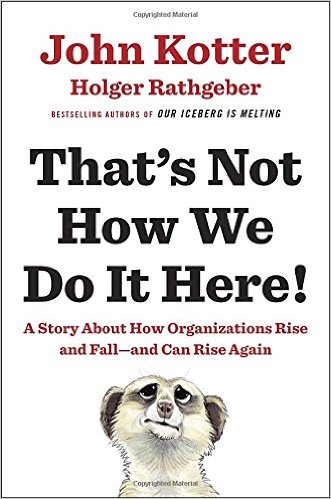Book Review: That’s Not How We Do It Here by John Kotter

“That’s not how we do it here.”
Those words, when said by an authority figure such as a boss or team lead, can stifle innovative thinking and cap the creative juices that are necessary for an organization to adapt to a changing environment.
I recently listened to John Kotter’s book by that title, That’s Not How We Do It Here! In this book Kotter, who has also written Leading Change and Our Iceberg Is Melting, offers a fable about a clan of meerkats who have created a successful and thriving organization. It’s highly structured with well-documented procedures for gathering food, building and maintaining tunnels, and watching for predators. The hierarchal organization offers predictable results with little risk. It works great as long as the landscape doesn’t change too much.
Unfortunately a series of unexpected events does change the clan’s environment. New and uncontrollable challenges threaten the clan’s very existence and the management structure that once supported the clan now seems to hinder it. The senior meerkats, steeped in the traditional way of surviving, have great difficulties adjusting because “That’s not the way we do it here!”
The rest of the book describes how a couple of meerkats leave the clan to learn how other clans do it. Along the way, they learn the difference between leadership and management and how both are required for an organization to survive and thrive. Leadership without structured management can lead to chaos. Management without leadership suppresses creativity and leads to an ineffective uses of resources and a slow, frustrating demise.
 I like books that use fables or fictional allegories that describe business principles that can be applied to the real-world. And Kotter does that well in this book. It effectively, if simplistically, draws the distinction between leadership and management. It shows how both are important, one more than the other at different stages of an organization’s development.
I like books that use fables or fictional allegories that describe business principles that can be applied to the real-world. And Kotter does that well in this book. It effectively, if simplistically, draws the distinction between leadership and management. It shows how both are important, one more than the other at different stages of an organization’s development.
The book falls a bit short of describing how to successfully create the balanced environment where both techniques are effectively practiced. That’s probably a bit ambitious for this kind of book, but nevertheless it left me wanting more.
Overall, I’d recommend the book. Maybe not at the top of my list of resources, but it’s worth the read.
